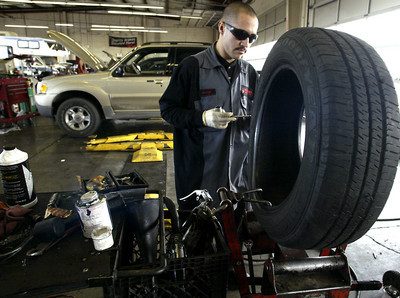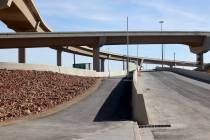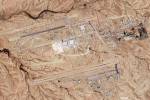Lots of hazards look to flatten tires
A few weeks ago I paid homage to a kind Las Vegas motorist who alerted me that one of my tires was low.
About a week after refilling the tire with air, I woke one morning to see that the suspect tire was once again in need of a refill.
I quickly deduced that there was probably something wrong with the tire. With that knowledge in hand, I proceeded to ignore the problem for several more weeks. I was content with refilling the tire as air seeped out.
On a recent refilling I stumbled upon the cause of the leak: a metallic cylinder, maybe a centimeter in diameter, not dissimilar to a nail, minus the head.
Of course, instead of getting the tire fixed, I became curious as to how big a problem this is in the valley, especially with our propensity for construction projects.
John Gaede, service manager at Ted Wiens Tire and Auto Center on North Decatur Boulevard, told me that 70 percent to 80 percent of the tire damage he sees is from construction debris on the roads.
"It's not just nails. I've pulled out metal files, metal punches, chunks of wood and staples," Gaede said. "There isn't a day that goes by that we don't have someone come in here" with that kind of problem.
Fixing a tire can be as easy as plugging the hole, which costs about $15, Gaede said. The rule is, if there are more than three holes, the tire cannot be repaired, he said.
And it also depends where the puncture is. If it is more than an inch from the side of the tire -- in the middle of the tread -- the tire can be saved. Any hole on the side makes it close to impossible to fix, Gaede said.
While Gaede has many residential customers, the bulk of his clientele are in the construction industry. After all, those folks are more apt to run over nails driving through construction sites.
One of the biggest clients Gaede services is a cable company that constantly has trucks going through construction sites.
But besides the nails and screws strewn across valley roads, there are other dangers.
"If you catch one of those metal plates on the road" -- the ones used to temporarily cover roadway excavation -- "at the wrong angle it can rip through a tire," Gaede said.
Among the new technologies out there to help motorists more easily check tire air pressure are tire check valve caps, he said. When air pressure is normal, a green button will be seen on the cap. When the pressure drops between 2 and 3 pounds per square inch, a red or yellow button will pop out.
I found them on the Internet for about $20 for a 4-pack. It is easier and cleaner to use them than dropping to your knees, unscrewing the cap and checking the pressure with a tire gauge.
Any vehicle made in the United States after Sept. 1, 2007, must have an electronic tire pressure monitoring system that indicates with a light on the dashboard that tire pressure is low. That law was passed during the Clinton administration, after rampant tire failure caused more than 100 deaths. But I digress.
Robert Feldman, secretary treasurer for the Nevada Insurance Council, told me besides nails in tires a major problem is broken windshields as gravel is kicked up by passing vehicles.
Feldman said things have been getting better, "especially right now since construction is way down."
This type of damage falls under comprehensive auto insurance, which is required of all by state law, Feldman said.
The reason is that, whether it's a nail in a tire or cracked windshield, it's awful hard to prove that a specific construction worker or company is liable.
"It's sort of like chasing (Osama) bin Laden. It's quite a job to get them (a construction company) to pay for the damage," he said, especially if there are no independent witnesses that the item that caused the damage came from a passing truck.
If, for instance, a truck runs over a rock and it kicks up into your windshield, it's not the truck driver's fault.
While most windshields fall within most drivers' deductible, some on newer model automobiles have become quite expensive, Feldman said. "These new models are connected with computers and antennas," he said, adding the cost can sometimes be more than $1,000.
Generally, comprehensive claims do not increase your insurance rates, but they can effect some insurance discounts. One of the latest fads in the industry is to give drivers a discount if they are claim-free, Feldman said.
And even if your claim falls within the deductible that a driver is responsible for, Feldman said some insurance companies keep track of it just because a claim was made.
For minor damage, he encouraged folks to get an estimate to determine whether it falls within the deductible. It may not be worth the hassle of a claim if it does, Feldman said.
As far as the nail in my tire. It's still there. After refilling the tire, I tend to forget about it as my mind gets lost in the daily distractions of life.
I've come to think of the nail as a pesky alarm clock and the grinding, 50-cent air pump at my local gas station as the snooze button.
But sooner or later, the tire will sink again. And another opportunity to put off the inevitable will avail itself.
Ah, sweet procrastination. Who knew it had a hissing sound?
If you have a question, tip or tirade, call the Road Warrior at 387-2904, or e-mail him at roadwarrior@reviewjournal.com or fmccabe@reviewjournal.com. Please include your phone number.
Motorists should watch for lane closures on Interstate 15, between Washington Avenue and Lake Mead Boulevard, starting at 9 p.m. Monday and continuing to 5 a.m. Tuesday, the Nevada Department of Transportation announced. Workers will be removing graffiti from signs and bridges.
The two right-hand lanes of southbound U.S. Highway 95, between Valley View Boulevard and the onramp to I-15, the U.S. 95 onramps at Decatur Boulevard and Valley View, the southbound U.S. 95 offramp to Rancho Road, and the connector to southbound I-15 will be closed from 10 p.m. Tuesday to 4 a.m. Wednesday to repair impact barrels.
The Las Vegas Public Works Department announced that Severnce Lane, between Oso Blanca and Campbell roads, will be closed starting Monday through May 29. The closure is for private development utility installations. Motorists should use Elkhorn Road as an alternate route for east-west travel.
Peak Drive, between Jones Boulevard and Maverick Street, should reopen by March 4, according to the Las Vegas Public Works Department. The road has been closed since March 2007 for road improvements.
REVIEW-JOURNAL




























